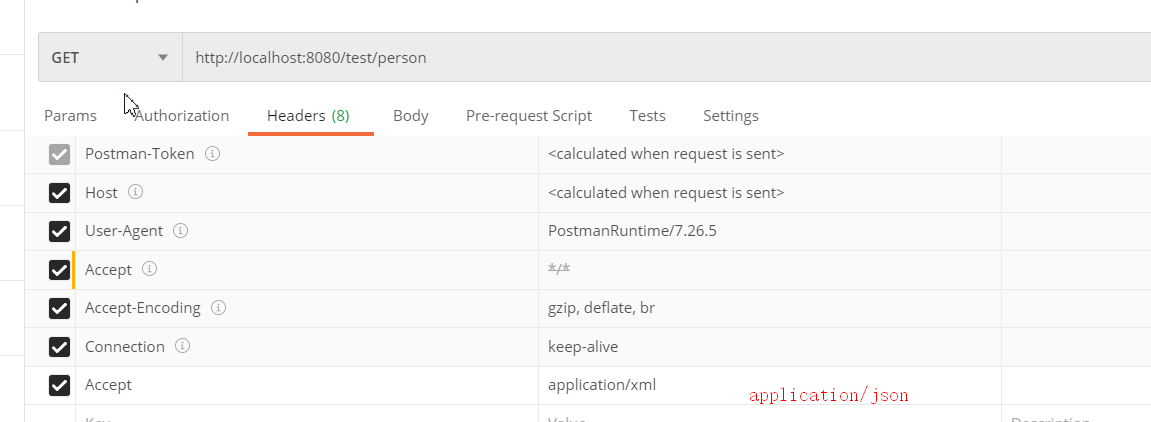目录
内容协商
1、引入xml依赖
2、postman分别测试返回json和xml
3、开启浏览器参数方式内容协商功能
4、内容协商原理
5、自定义 MessageConverter
综上
内容协商
根据客户端接收能力不同,返回不同媒体类型的数据。
若客户端无法解析服务端返回的内容,即媒体类型未匹配,那么相应406。
1、引入xml依赖
默认没有返回xml的能力
<dependency><groupId>com.fasterxml.jackson.dataformat</groupId><artifactId>jackson-dataformat-xml</artifactId>
</dependency>2、postman分别测试返回json和xml
只需要改变请求头中Accept字段。(Http协议中规定的,告诉服务器,该客户端可以接收的数据类型。)

3、开启浏览器参数方式内容协商功能
spring:mvc:contentnegotiation:# 开启请求参数内容协商模式favor-parameter: true# 修改parameterName,默认为formatparameter-name: xx发请求格式:
http://localhost:8080/test/person?format=json
http://localhost:8080/test/person?format=xml

注意:1.如果没有定义参数名字,默认parameterName为format。
2.引入jackson转换xml包后,则支持json、xml两种媒体类型。(如果需要其他类型数据,可自定义MessageConverter,实现多协议数据兼容)
浏览器端不传参数或者是没匹配到,就是"*/*",都能匹配,然后按权重匹配。
4、内容协商原理
内容协商的内容在返回值处理器 RequestResponseBodyMethodProcessor->writeWithMessageConverters() 方法中
- 1、判断当前响应头中是否已经保存了 MediaType,如果有则该 MediaType 作为 selectedMediaType。

- 2、否则,先获取浏览器可接受的所有MediaType: acceptableType

获取的原理:调用返回值处理器的内容协商管理器来获取到当前请求头中 Accept 字段的值,封装到 List 中,并按权重进行排序。

- 3、获取支持当前返回值类型的 MessageConverter 所支持的所有 MediaType:producibleTypes。

获取的原理:获取当前处理器中保存的所有 MessageConverter,匹配支持当前返回值类型的 MessageConverter,将这些 MessageConverter 支持的所有 MediaType 返回。

- 4、对两种类型进行最佳匹配,筛选出所有可以使用的 MediaType:mediaTypesToUse

对 mediaTypesToUse 按权重进行排序,优先选中优先级较高的作为选定的 MediaType:selectedMediaType。如果匹配到不是具体的 MediaType(带通配符 *),则 selctedMediaType = application/octet-stream。


- 5、遍历循环所有当前系统的 MessageConverter,匹配支持将当前返回值类型 转换为 selectedMediaType 的 MessageConverter,并使用其 write() 方法将当前返回值写入到响应体中。


5、自定义 MessageConverter
实现多协议数据兼容。json、xml、xx-media。
如何新增一个自定义的xx-media格式?
使用spring boot可以基于配置文件快速修改媒体类型。
spring:mvc:contentnegotiation:# 开启请求参数内容协商模式favor-parameter: true# 修改parameterName,默认为formatparameter-name: xx# 自定义媒体类型media-types:xx-media: application/xx-media或者如果不修改xml文件,还可以通过重写configureContentNegotiation方法来实现。
@Configuration
public class WebConfig {@Beanpublic WebMvcConfigurer webMvcConfigurer () {return new WebMvcConfigurer() {@Overridepublic void configureContentNegotiation(ContentNegotiationConfigurer configurer) {configurer.mediaType("xx-media", MediaType.parseMediaType("application/xx-media"));}@Overridepublic void extendMessageConverters(List<HttpMessageConverter<?>> converters) {converters.add(new CustomConverter());}};}
}配置完,可以看到客户端、浏览器可接收的媒体类型如下:

无论使用xml形式,还是重写configureContentNegotiation都需要写一个自定义converter。
举个例子,只处理写数据。
public class CustomConverter implements HttpMessageConverter<User> {@Overridepublic boolean canRead(Class clazz, MediaType mediaType) {return false;}@Overridepublic boolean canWrite(Class clazz, MediaType mediaType) {return clazz.isAssignableFrom(User.class);}@Overridepublic List<MediaType> getSupportedMediaTypes() {return MediaType.parseMediaTypes("application/xx-media");}@Overridepublic User read(Class clazz, HttpInputMessage inputMessage) throws IOException, HttpMessageNotReadableException {return null;}@Overridepublic void write(User user, MediaType contentType, HttpOutputMessage outputMessage) throws IOException, HttpMessageNotWritableException {// 自定义协议数据写出String data = user.getName() + "---" +user.getSex() + "---" + user.getAge();//写出去OutputStream body = outputMessage.getBody();body.write(data.getBytes());}
}请求结果显示如下:

综上
无论使用浏览器参数访问形式,还是通过postman修改请求头的accept接收值,都可以支持application/xml、application/json、application/xx-media类型的数据。




)


)
)




)





